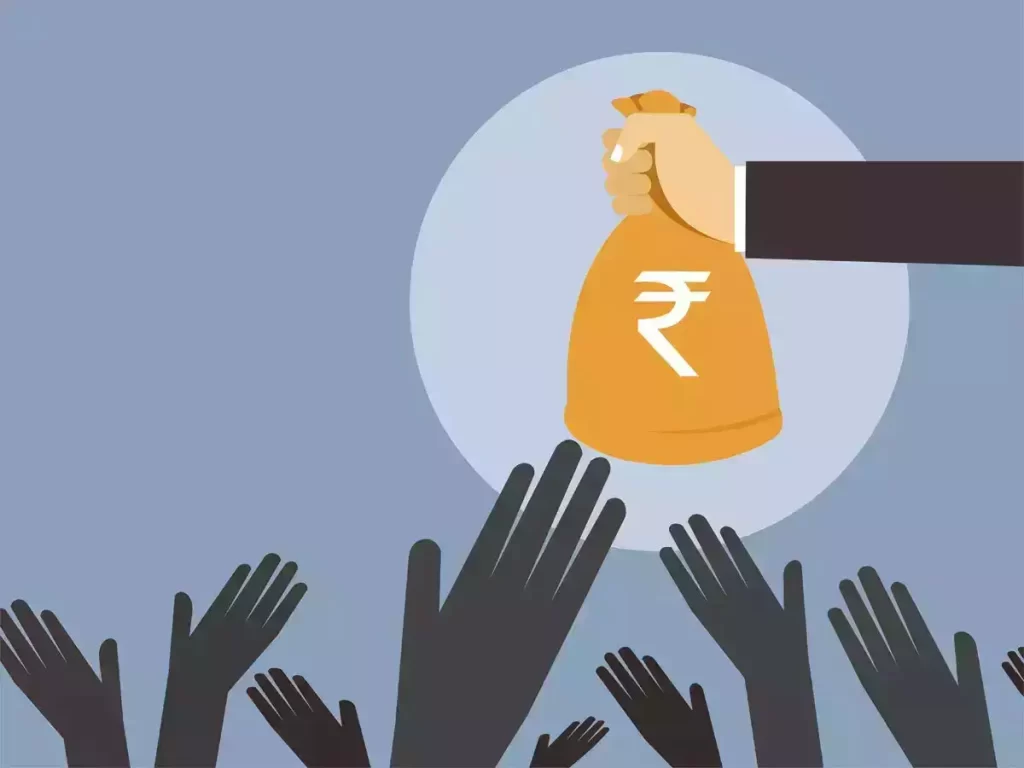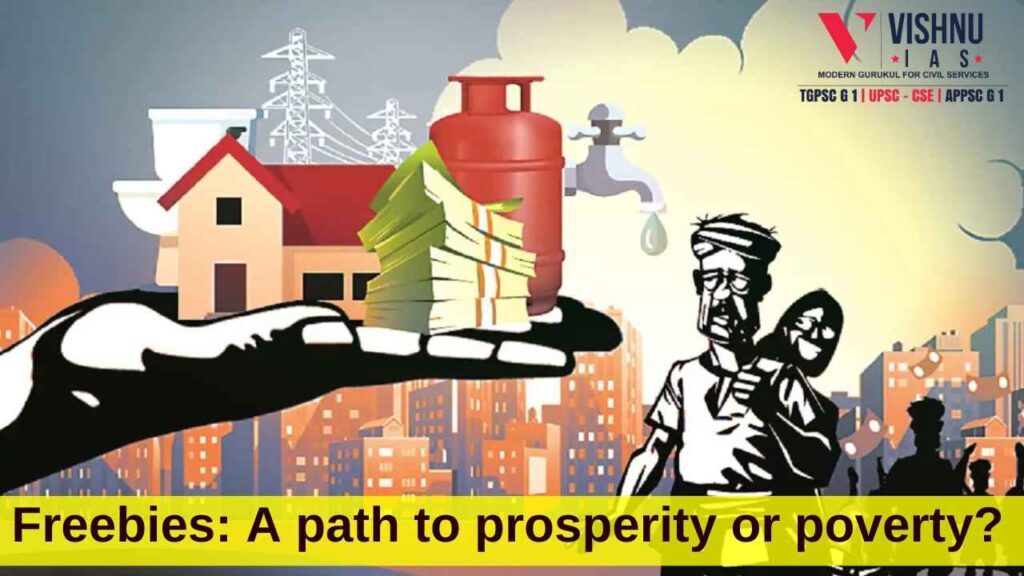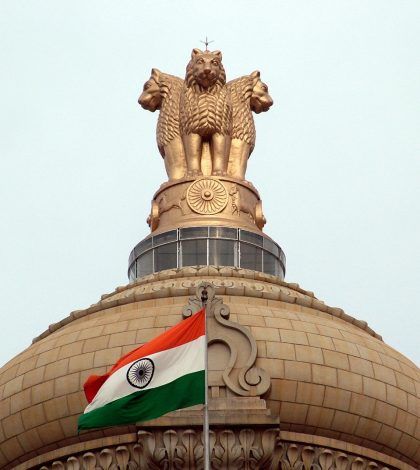Freebies: A path to prosperity or poverty?
The Prime Minister recently remarked that state-provided freebies may yield political results in the short term, but it will lead to a great social and economic price in the long term with the poor paying a heavy price.
It is well-established that every election season, political parties across the board make ambitious expenditure commitments in a bid for electoral success
The Political parties with an aim to win elections promise the provision of various freebies like electricity, water and transportation. Providing free electricity has been the most popular among all the promises.
What is Freebie?
In a Reserve Bank of India report in 2022, freebies have been defined as “a public welfare measure that is provided free of charge”. It adds that freebies are different from public/merit goods such health and education, expenditure on which has wider and long-term benefits.
What is the Difference between Freebies and Welfare?
The difference between freebies and welfare schemes is not always clear, but a general way to distinguish them is by their long-term impact on beneficiaries and society. Welfare schemes have a positive impact, while freebies can create dependency or distortions.
Freebies are goods and services given free without any charge to the users.
- They are generally aimed at benefiting the targeted population in the short term.
- They are often seen as a way of luring voters or bribing them with populist promises.
- Some examples of freebies are free laptops, TVs, bicycles, electricity, water, etc
Welfare schemes, on the other hand, are well thought-after plans that aim to benefit the target population and improve their standard of living and access to resources.
- They are typically aimed at fulfilling the constitutional obligations (Directive Principles of State Policy) towards citizens.
- They are often seen as a way of promoting social justice, equity, and human development.
- Some examples of welfare schemes are public distribution system (PDS), Mahatma Gandhi National Rural Employment Guarantee Act (MGNREGA), mid-day meal scheme, etc.
Freebies: A path to poverty

Disadvantages of Freebies
1.Dependency Syndrome: Freebies can create a negative pattern of dependency and entitlement among the recipients, who may expect more freebies in the future and become less motivated to work hard or pay taxes. For example, freebies such as rice at Rs 1 per kg or electricity at zero cost can reduce the sense of responsibility and accountability of the beneficiaries and make them dependent on external aid.
- A survey by the Association for Democratic Reforms showed that 41% of voters in Tamil Nadu considered freebies as an important factor in voting, while 59% said they were satisfied with the performance of the state government.
2. Fiscal Burden: Freebies can have adverse consequences on the fiscal health and macroeconomic stability of the state or the country, by increasing public expenditure, subsidies, deficits, debts, and inflation. For example, freebies such as farm loan waivers, unemployment allowances, or pension schemes can strain the budgetary resources and fiscal discipline of the government and affect its ability to invest in other sectors or repay its obligations.
- A report by RBI analysed that freebies such as pension schemes for senior citizens under the Indira Gandhi National Old Age Pension Scheme (IGNOAPS) posed a fiscal risk for the central and state governments, as they implied an increasing pension liability with an ageing population.
3. Heavy Tax Burden on States: Many states are burdened with substantial debts, limiting their capacity to invest in more significant welfare programs.
- Punjab’s electricity subsidy constitutes over 16 percent of its total revenues.
- State Finance: A Risk Analysis’, a report released by the RBI in June 2022, stated that the slowdown in state revenues and increasing subsidy burden have added to the state government’s debt.
- New sources of risks have emerged in the form of rising expenditure on nonmerit freebies, expanding contingent liabilities, and the ballooning overdue of DISCOMs.
4. Resource Misallocation: Freebies can distort the expenditure priorities and allocation of resources, by diverting funds from more productive and essential sectors such as infrastructure, agriculture, industry, etc. For example, freebies such as mobile phones, laptops, or air conditioners can consume a large share of public spending and crowd out investment in public goods such as roads, bridges, irrigation systems, or power plants.
- A report by the NITI Aayog criticised that freebies such as laptops given by the Uttar Pradesh government diverted funds from more urgent needs such as improving school infrastructure, teacher quality, or learning outcomes
5. Quality Compromise: Freebies can lower the quality and competitiveness of the goods and services that are given for free, by reducing the incentives for innovation and improvement. For example, freebies such as bicycles or laptops may be of inferior quality or outdated technology compared to those available in the market or those produced by other countries.
- A report by the Centre for Development of Advanced Computing assessed that freebies such as laptops given by various state governments were based on obsolete technology and software, which limited their functionality and performance.
6. Against Constitutional Principles: Making promises when the states lack money to guarantee fundamental rights and implement directive principles is against constitutional principles.
7. Shrinkage of fiscal space: The subsidy burden needs to be to be funded through debt, which will result in mounting deficits
- It will lead to breach of Fiscal Responsibility and Budget Management (FRBM) rules and the states ending up in a debt trap.
- The report also reveals that the debt-GSDP ratio is the highest in Punjab, Rajasthan, Kerala, West Bengal, Bihar, Andhra Pradesh, Jharkhand, Madhya Pradesh, Uttar Pradesh, and Haryana. emerged in the form of rising expenditure on nonmerit freebies, expanding contingent liabilities, and the ballooning overdue of DISCOMs.
- Debt-to-gross state domestic product ratio(Debt-GSDP): It is a measure of how much the liabilities are as a proportion of the size of the state’s economy.
8. Violation of the principle of a level-playing field: Freebies gives the political parties undue advantage by making promises to provide private goods for only a section of voters.
- For instance, promising cycles for girl students or laptops for college students, or grinders for housewives, etc.
- Against free and fair elections
9. Opportunity Cost: States offering loan waivers often have to cut spending on crucial infrastructure such as roadways development and skill development.
- Leads to crowding out of industries
10. Social Impact: Despite receiving more resources, the RBI’s study reveals a decline in social sector spending by states, particularly in vital areas like health and education.
- The share of subsidies in the total revenue expenditure of states has increased from 7.8 per cent in 2019-20 to 8.2 per cent in 2021-22.
- States like Punjab and Chhattisgarh are on top as they spend 10 percent of their revenue expenditure on subsidies.
- For example, Karnataka’s budget allocations for education and health are lower than the average allocations in these sectors by all States.
11. Environmental concerns: Freebies can have a negative impact on the environment, by encouraging overuse and wastage of natural resources, such as water, electricity, or fuel. For example, freebies such as free power, free water, or free gas cylinders can reduce the incentives for conservation and efficiency and increase the carbon footprint and pollution levels
- In Punjab and Haryana, the ground water extraction stands at 161 % and 134 % against the national average of 61 % due to highly subsidised electricity.
Advantages of Freebies

1.Public Outreach and Engagement: Government freebies can increase public trust and satisfaction with the government, as they demonstrate its responsiveness and accountability to the people. Moreover, freebies can create
opportunities for feedback and dialogue between the government and the citizens, enhancing transparency and democracy
- A study by the Centre for Policy Research found that freebies such as laptops, bicycles, and cash transfers had a positive impact on voter turnout, political awareness, and satisfaction with the government in Uttar Pradesh and Tamil Nadu.
2.Economic Growth: Freebies can stimulate economic growth by increasing the productive capacity of the workforce, especially in less developed regions. For example, freebies such as laptops, bicycles, or sewing machines can enhance the skills, mobility, and income opportunities of the poor and rural population.
- A report by the NITI Aayog stated that freebies such as bicycles given to schoolgirls in Bihar and West Bengal increased their enrolment and retention rates, reduced dropout rates, and improved their learning outcomes.
3.Social Welfare: They can provide basic necessities and social welfare to the poor and marginalized sections of society, such as food, education, health, electricity, etc. For example, freebies such as uniforms, textbooks, or health insurance can improve the literacy, health, and quality of life of the needy and vulnerable groups.
- A study by the World Bank estimated that freebies such as food subsidies under the Public Distribution System (PDS) reduced the poverty ratio in India by 7% in 2011-12.
- A survey by the NSSO revealed that freebies such as health insurance under the Rashtriya Swasthya Bima Yojana (RSBY) reduced the outof-pocket expenditure and catastrophic health shocks for below poverty line households
4.Income Equality: Freebies can reduce income inequality and poverty by redistributing wealth and resources more equitably. For example, freebies such as loan waivers, or cash transfers can empower the indebted, or low-income households by giving them access to assets, credit, or income support.
- A report by the Reserve Bank of India analysed that loan waivers relieved the debt burden and improved the creditworthiness of distressed farmers.
Here Is The Difference Between Freebies And Subsidies
Challenges in curtailing Freebie Culture:

- Lack of regulatory powers with ECI: The Election Commission of India (ECI) has stated that it lacks the authority to regulate or penalize political parties for making electoral promises. According to the ECI, the offering or distribution of freebies, either before or after an election, falls under the jurisdiction of the respective party.
- No assessment of financial viability of populist policies: Political parties often fail to clarify the funding sources for the promises made in the form of freebies.
- Lack of Information to the Voters: They don’t delve into the financial aspects of freebies, prompting political parties to compete for promising freebies.
Supreme Court response on Freebies:
- The Supreme Court Bench in a recent judgment proposed the constitution of an apex body, to address the issue of freebies and poll promises.
- It will comprise several stakeholders like the Niti Aayog, Law Commission, Finance Commission, Reserve Bank of India and members of ruling party and opposition parties.
- The reference is a shift from the court’s own stand in the S. Subramaniam Balaji vs Tamil Nadu judgment of 2013.
S. Subramaniam Balaji vs Tamil Nadu judgment of 2013.
The court had held that making promises in election manifestos does not amount to a ‘corrupt practice’ under Section 123 of the Representation of People Act (RP).
Way Forward:
Drawing a Line Between Welfare and Freebie: Freebies must be understood from an economic perspective and connected to taxpayers’ money.
- Differences between subsidy and freebie are also essential since subsidies are justified and specially targeted benefits meant to meet specific demands. The freebies, on the other hand, are quite different.
Drawing a Line Between Welfare and Freebie: Freebies must be understood from an economic perspective and connected to taxpayers’ money.
- Differences between subsidy and freebie are also essential since subsidies are justified and specially targeted benefits meant to meet specific demands. The freebies, on the other hand, are quite different.
Clear Rationale and Indication of Funds: Political parties should be required to disclose the financing and trade-offs of freebies to the voters and the ECI before announcing them. This would include specifying the sources of revenue, the impact on fiscal balance, the opportunity cost of public spending, and the sustainability of freebies.
Empower the Election Commission of India: ECI should be provided more powers to regulate and monitor the announcement and implementation of freebies by political parties during elections. This would include giving the ECI more powers to de-register parties, impose penalties, or take contempt action for violating the model code of conduct or the court orders on freebies.
Model Manifesto: The ECI needs to prepare a Model manifesto to be followed by all political parties.
- ECI could bring in certain measures under the MCC to introduce a responsible way of making promises to the public.
- Voters need to decide whether an election campaign is credible and whether the promises and the freebies are in their interest.
Voter Awareness: In a democracy, the power to block or allow the march of freebies rests with the voters. Educating voters about the economic and social consequences of freebies and encouraging them to demand performance and accountability from political parties. This would include creating awareness campaigns, voter literacy programs, civil society initiatives, and media platforms to inform and empower voters to make rational and ethical choices.
Judicial Intervention: A constructive debate and discussion in parliament is difficult since the freebie culture has an impact on every political party, whether directly or indirectly. Therefore, judicial involvement is required in order to propose measures.
- The Supreme Court has suggested setting up an expert committee to look into the issue of freebies and their impact on the economy and democracy. The committee would consist of members from the Niti Aayog, the Finance Commission, the RBI and other stakeholders. The committee would make suggestions on how to control freebies given by political parties during election campaigns.
Focus on Inclusive Development: It would address the root causes of poverty, inequality, and exclusion that make people vulnerable to freebies. Inclusive development would also create a more conducive environment for economic growth and social progress, which would benefit all sections of society in the long run. Therefore, inclusive development can be a more effective and desirable alternative to freebies.
- It can be understood well through this quote – “Give a man a fish and you feed him for a day, teach a man to fish and you feed him for a lifetime.”
Role of Finance Commission: It should consider the state’s debt burden during state allocations, and assess whether the state’s economy can sustain the financial impact of freebies over the long term.
- A committee should be formed comprising constitutional bodies, such as the Law Commission of India, to put down a proposal on how to deal with the issue.
Value addition:
National Pension System (NPS) vs Old Pension System (OPS):
- Under the OPS: Retired government employees get 50% of their last-drawn salary as a monthly pension. The amount keeps rising with hikes in the dearness allowance rates.
- In contrast, NPS is a defined contribution scheme wherein the subscriber contributes to his account, there is no defined benefit that would be available at the time of exit from the system.
- OPS as a populist move: The choice of certain states to revert to the old pension scheme (OPS) has been criticized as a populist measure to attract government employees.
- Five states – Rajasthan, Chhattisgarh, Jharkhand, Punjab, and Himachal Pradesh have decided to go back to the OPS.
- In Delhi, free ride passes for women in the Delhi Transport Corporation (DTC) alone would cost around Rs. 300 crore. per year. It will make the passengers, who can afford the fare, irresponsible. It may not help the poor
Anecdote:
1. In the bustling state of Punjab
- The promise of free electricity for farmers became a cornerstone of a political campaign. Initially, it seemed like a boon – farmers cheered, and the party won. However, the reality painted a different picture.
- The initial euphoria gave way to a system under strain. Farmers, no longer mindful of electricity costs, ran their pumps round the clock, depleting groundwater reserves at an alarming rate. The state’s power grid creaked under the increased load, leading to frequent blackouts in urban areas.
- The free electricity scheme, initially hailed as a savior, turned out to be a double-edged sword. It strained resources, disrupted lives, and exposed the pitfalls of short-sighted populist measures.
2. The Bolivar's Worthless Journey
Once, a Venezuelan grandmother could buy a week’s groceries with a single Bolivar bill. It was crisp, bearing the image of Simon Bolivar, the nation’s liberator. But times changed. Oil prices, the lifeblood of the Venezuelan economy, began to ebb. The government, in a bid to maintain popularity, ramped up spending. Free housing, food, and gasoline became the norm.
Soon, the Bolivar began to lose its value at a dizzying pace. The grandmother, once content, now needed a sackful of bills to buy a loaf of bread. Her pension, meager at best, was swallowed by inflation. The once-proud Bolivar ended up as worthless as the paper it was printed on. Children used it for play money, unaware of its historical significance. This hyperinflation, a direct consequence of unchecked spending, became a stark symbol of Venezuela’s economic collapse.
3. Venezuela: A Tale of Oil and Overspending
Venezuela, once a prosperous nation brimming with oil wealth, found itself spiraling into economic chaos. The seeds of this crisis were sown in the early 2000s when the government, led by Hugo Chavez, initiated a wave of populist policies. These included generous subsidies on everything from gasoline to food, and lavish social programs.
Initially, fueled by high oil prices, these policies seemed like a boon. However, the underlying economic structure remained fragile. The nation became heavily reliant on oil revenues, neglecting other sectors and failing to build a sustainable economy. When oil prices plummeted, the government’s coffers emptied rapidly.
The freebies, once a source of popularity, became unsustainable. Inflation soared, shelves emptied, and basic goods became scarce. The once-wealthy nation found itself grappling with shortages, crime, and mass emigration. Venezuela’s story is a stark reminder of the dangers of unchecked spending and the importance of economic diversification.


